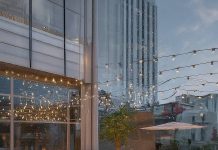
What is it?
The 47-story, 565-foot-tall tower at 645 Griswold in downtown Detroit is the largest of three Penobscot buildings. At the time it opened in 1928, it was the eighth tallest building in the world and remained the tallest in Detroit until 1977, when the Renaissance Center opened at 729 feet. In 1993, the Ally Detroit Center opened at 619 feet, demoting the Greater Penobscot to the city’s No. 3.
What’s special about the Greater Penobscot?
The building is a splendorous example of the Art Deco era, particularly with its ziggurat-like apex, many artistic tributes to Native Americans, and its striking H-shaped front facade intended to maximize natural light inside. The lower levels boast work by master sculptor Corrado Parducci, including relief work in which an American Indian hunts wolves and buffalo with a bow and arrow. When the 12-foot-wide red beacon atop is lit, it can be seen from 40 miles away.
Who occupies it?
Because a suite of Wayne County Court offices is located in the Penobscot, dozens of law firm offices also populate its floors, along with the Detroit Metropolitan Bar Association and the Wolverine Bar Association. Those attorneys need to eat, so there’s Detroit Donuts, Which Wich Superior Sandwiches, Athens Souvlaki, and Carnival Fresh Mex. Beyond that, there’s an eclectic array of tenants, including the Christian Television Network, a piano instructor, a dentist, a travel agency, a Comerica branch, a wedding photographer, a recording studio, and the “No. 1 celebrity Indian DJ service,” DJ Ice and Fresh Productions.
What’s it named for?
Builder Simon J. Murphy named the landmark complex after a Native American tribe in New England as a tribute to his youth spent working on the Penobscot River in Maine. Murphy died in 1905, two decades before the Greater Penobscot, the third structure, was completed. In 1972, it was renamed City National Bank Building and a CNB logo was affixed to its top, but the Penobscot name was officially restored in 1983 after the bank was acquired by First American. The move was celebrated; the Detroit Free Press editorial board wrote that the decision meant that “right, justice, and truth can prevail … sometimes.”
Why is the Greater Penobscot in the news lately?
It’s falling apart — overheating boilers, overflowing toilets, power outages — and it doesn’t seem like the current owners, Triple Properties of Toronto, much care. The company wants $100 million for the building, which it bought for $5 million in 2012. “It’s so sad because our view is so gorgeous — you can overlook the Detroit River, we can see Windsor,” paralegal Deanna Denby, who works on the 41st floor, told the Detroit Free Press in March. “But the building is just horrible on the inside.” In 2020, the city issued 177 blight tickets and fines for the building. Triple is owned by Greek-Canadian businessman Andreas Apostolopoulos, whose firm also oversaw the decline of the Pontiac Silverdome.
|
|
|









